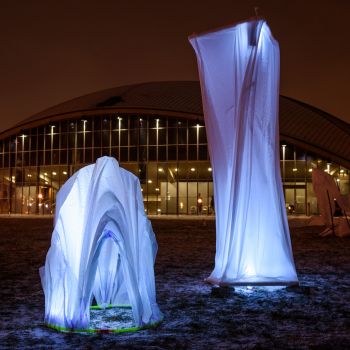We are Digital Structures, a research group at MIT working at the interface of architecture, structural engineering, and computation. We focus on the synthetic integration of creative and technical goals in the design and fabrication of buildings, bridges, and other large-scale structures. We are particularly interested in how digital techniques and tools can play an unexpected, collaborative role in these processes. Led by Professor Caitlin Mueller, the group is based in MIT’s Building Technology Program in the Department of Architecture, and also includes contributors from Civil and Environmental Engineering, and the Center for Computational Engineering.
Recent News
-
 Yijiang Huang presents at ROB|ARCH 2018 in Zurich2018-09-14
Yijiang Huang presents at ROB|ARCH 2018 in Zurich2018-09-14Yijiang Huang presented his paper, Robotic Extrusion of Architectural Structures with Nonstandard Topology, co-authored by Josephine Carstensen, Lavender Tessmer, and Caitlin Mueller, at the 2018 Robotic Fabrication in Architecture, Art, and Design 2018 Conference held at ETH Zurich. The presentation marked the first public presentation of the Choreo robotic path planning platform.
-
 Paul Mayencourt embarks on month-long research trip to Japan2018-08-01, Tags: timber
Paul Mayencourt embarks on month-long research trip to Japan2018-08-01, Tags: timberPaul Mayencourt is spending the month of August in Japan for a research fellowship with the Japanese Association for the Promotion of Science (JSPS). His travels will include study and documentation of wood structures, architecture ,and furniture. For a glimpse into his trip, check out his Instagram.
-
 MIT hosts IASS 2018 Symposium, Creativity in Structural Design2018-07-16
MIT hosts IASS 2018 Symposium, Creativity in Structural Design2018-07-16MIT Architecture and Civil and Environmental Engineering host the 2018 Symposium of the International Association of Shell and Spatial Structures, with the theme of Creativity in Structural Design. Caitlin Mueller is chair the Organizing Committee for the event, along with Sigrid Adriaenssens, Bill Baker, John Ochsendorf, and John Abel as co-chairs. The week-long event welcomes more than 600 participants from academia and practice, architecture and engineering, and more than 40 countries to the iconic Kresge Auditorium on the MIT campus. More than 450 papers are presented in technical sessions during the week, along with 10 plenary talks and pre-symposium workshops. Digital Structures researchers and alumni are well represented at the event through paper presentations and workshops, as well as serving as volunteers in a wide range of tasks to keep the event running smoothly.
Selected Publications
-
 Automated sequence and motion planning for robotic spatial extrusion of 3D trussesYijiang Huang, Caelan R. Garrett and Caitlin T. Mueller, Preprint, arXiv:1810.00998, 2018
Automated sequence and motion planning for robotic spatial extrusion of 3D trussesYijiang Huang, Caelan R. Garrett and Caitlin T. Mueller, Preprint, arXiv:1810.00998, 2018While robotics for architectural-scale construction has made significant progress in recent years, a major challenge remains in automatically planning robotic motion for the assembly of complex structures. This paper proposes a new hierarchical planning framework to solve the assembly planning problem for architectural discrete structures, which usually have a long planning horizon and 3D configuration complexity. By decoupling sequence and motion planning, the planning framework is able to efficiently solve the assembly sequence, end-effector poses, joint configurations, and transition trajectories for assembly of spatial structures with nonstandard topologies, which hasn't been demonstrated in previous literature. Together with the algorithmic results, this paper also presents an open-source and modularized software implementation called Choreo that is machine and application-agnostic. To demonstrate the power of this algorithmic framework, three case studies, including real fabrication and simulation results, are presented to show Choreo's application on spatial extrusion.
-
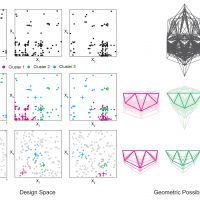 Designing with data: moving beyond the design space catalogNathan Brown and Caitlin Mueller, ACADIA, 2017
Designing with data: moving beyond the design space catalogNathan Brown and Caitlin Mueller, ACADIA, 2017Design space catalogs, which present a collection of different options for selection by human designers, have become commonplace in architecture. Increasingly, these catalogs are rapidly generated using parametric models and informed by simulations that describe energy usage, structural efficiency, daylight availability, views, acoustic properties, and other aspects of building performance. However, by conceiving of computational methods as a means for fostering interactive, collaborative, guided, expert-dependent design processes, many opportunities remain to improve upon the originally static archetype of the design space catalog. This paper presents developments in the areas of interaction, automation, simplification, and visualization that seek to improve on the current catalog model, while also describing a vision for effective computer-aided, performance-based design processes in the future.
-
 Digital brainstorming: New computational tools for creative data-driven designCaitlin Mueller, Nathan Brown, and Renaud Danhaive, ABX 2015: Conference for the Boston Society of Architects, 2015
Digital brainstorming: New computational tools for creative data-driven designCaitlin Mueller, Nathan Brown, and Renaud Danhaive, ABX 2015: Conference for the Boston Society of Architects, 2015This session focuses on tools that link conceptual design decisions in architecture to quantitative and qualitiative performance metrics, such as structural material volume, energy consumption, daylighting quality, and formal and spatial qualities. Developed by the Digital Structures research group at MIT, these tools emphasize design over analysis, aiming to help designers explore a wide range of diverse, surprising, and high-performing alternatives for conceptual design problems. Participants will learn strategies for using the tools in their own practices to navigate conceptual building design problems in a flexible yet data-driven way.
Featured Projects
Recent Blog Posts
-
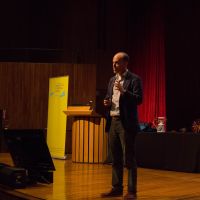 Embrace the constraints and seek new challenges: In conversation with Professor John Ochsendorf2018-12-13, Author: Demi Fang
Embrace the constraints and seek new challenges: In conversation with Professor John Ochsendorf2018-12-13, Author: Demi FangJohn Ochsendorf is the Director of the American Academy in Rome and the Class of 1942 Professor of Architecture and Engineering at the Massachusetts Institute of Technology (MIT). Ochsendorf is a 2008 Rome Prize Fellow in Historic Preservation, known for his research on the mechanics and behavior of historical structures, with a primary focus on masonry vaults and domes. Author of the monograph Guastavino Vaulting: The Art of Structural Tile (Princeton Architectural Press, 2010), he served as lead curator for the National Endowment for the Humanities sponsored exhibition Palaces for the People: Guastavino and America’s Great Public Spaces from 2012-2014. As a designer, he contributed to the masonry vaulting of the Mapungubwe Interpretative Centre in South Africa, which was named “World Building of the Year” at the World Architecture Festival in 2009, as well as two major installations at the Venice Biennale of Architecture in 2016. Ochsendorf contributed to the design of the Sean Collier Memorial for the fallen MIT police officer in the aftermath of the Boston Marathon bombings. He was awarded a Fulbright Scholarship to Spain in 2000, as well as the MacVicar Fellowship for exceptional teaching at MIT in 2014. In 2008 he was named a MacArthur Fellow for his pioneering work using comparative cultural and historical studies to explore pre-industrial construction traditions. He is a founding partner of the consultancy firm Ochsendorf, DeJong and Block, and in 2011 Ochsendorf was named a Senior Fellow of the Design Futures Council.

Professor John Ochsendorf gives a keynote at IASS 2018, hosted at MIT. Photo by Julia Irwin.Demi Fang: What is something you are currently working on that excites you?
John Ochsendorf: I am mostly thinking about education and community. How do we help develop young minds to be creative problem solvers? And how do we create communities of learning so that we can fully develop our human potential? I am mostly working in the context of higher education, but these problems apply to industry and society more broadly. In particular, we are all living and working in human environments every day, but we have not reached the full potential of cities or of living communities. This is the ultimate design problem.
DF: The theme of the conference is “Creativity in Structural Design.” How do you interpret this theme? What does it bring to mind?
JO: It makes me think about my education. While trained as an engineer, I was almost always given problems with a single solution, which has the effect of narrowing the mind when faced with complex problems. While studying anthropology and archaeology, I saw the brilliant diversity of problem-solving in human culture, with infinite solutions to any problem. After 15 years of teaching in architecture, I appreciate that framing a design problem is a critical skill for any human being. The world is desperate for the analytical rigor of engineering with the creative potential of art and architecture. Our work should lift the human spirit through creativity.

Armadillo Vault, Venice Biennale of Architecture, 2016, Block Research Group (ETHZ)/Escobedo Group/ ODB Engineering (Photo: Iwan Baan)DF: Who inspires you and your work?
JO: I am always learning from the past and from the people around me. While living in Rome and serving as the Director of the American Academy in Rome, I am immersed in layers of history. All of it is thought-provoking. But even better, I am embedded within a community of some of the most brilliant and creative people on the planet. While the backdrop of Rome is inspirational, I am even more inspired by the individual life paths and the passion of the designers and researchers who I am meeting here.
I still shake my head at the genius of the Guastavino Company. To imagine that they designed and built a three-dimensional compressive shell structure like the tile stair at Baker Hall without the design tools that we have today... that inspires me.

Baker Hall Staircase, Carnegie Mellon University, 1914, by Rafael Guastavino Jr. with Henry Hornbostel (Photo: Michael Freeman)DF: Describe the collaborations in your work. What do you think makes for successful collaborations? In what ways do you blend the technical and creative aspects of your work?
JO: It is exciting to work at the boundaries between university research and design practice. We love to collaborate with colleagues who want to tackle a real problem, such as radically lowering carbon emissions in construction, or reinventing traditional materials in contemporary architecture, or developing new software environments for design practice. When a design team is driven by a common goal, it makes for an exciting and effective collaboration. But this always requires a high level of trust; any attempt to bring research into practice requires experimentation and innovation. It is never easy in the context of public safety and building code regulations. We need to continue exploring and pushing boundaries, and I always enjoy a successful collaboration for testing our ideas out on others. To blend the technical and creative, we articulate the technical constraints and use them to drive creative solutions. Want to be creative? Embrace the constraints.

Pines Calyx Dome, 2005, Phil Cooper / Michael Ramage / John Ochsendorf (Photo: Carbon Free Group)DF: What methods do you use to fuel creativity? How do you work?
JO: I love to work in a diverse team where good ideas come from all directions. The ideas can be debated and dismissed, and when we move forward with a design, it is sometimes difficult to remember who proposed the key ideas. I enjoy challenges that are well outside of my comfort zone. To be a creative designer or researcher is to constantly seek new challenges. That makes for an exciting life.

Sean Collier Memorial, 2015, Howeler + Yoon Architecture / ODB Engineering / Quarra Stone / Knippers Helbig (Photo: Scott Newland)DF: What are currently the most pressing, interesting technical challenges that you tackle in your work, at present or in the future?
JO: I am deeply frustrated with the over-reliance on linear elastic calculations during the design stage. The preponderance of FEM can be a powerful design aid, but FEM alone will not suggest good structural form. We have not come close to harnessing the full potential of computing as a design partner. I hope that we will find more creative ways to use computing power to discover new structural form. Until then, I remain more impressed by the radical forms of the Salginatobel Bridge and the Eiffel Tower discovered through graphic statics by Maillart and Koechlin.

DronePort, Venice Biennale of Architecture, 2016, Norman Foster Foundation / Block Research Group / ODB Engineering. (Photo: Nigel Young)DF: What excites you about the future in your field?
JO: I always think to the words of Joerg Schlaich: our field is both “high-tech and creative.” And yet the greatest motivation is that humankind is facing an unprecedented global crisis and that the better design of buildings and cities is the only viable solution. We need to convince the best and brightest young people to enter our professions of engineering and architecture. This is a crisis and an opportunity.
DF: Describe the impact of your work: when your work leaves your workspace, who and where in the world does it reach?
JO: I love to reach students first and foremost. To inspire students to learn about the built environment: its past, present, and future. The joy of teaching is that students take the ideas forward into the world and ripple out in infinite new directions. There is no greater joy than to teach and to share passion. As Edward Allen says, “Love your subject and teach with stars in your eyes.”
DF: What advice would you give to your past self or to today’s students?
JO: The world needs more adventurous students to branch out in new directions and to combine unusual fields of study. Helen Keller said that “Life is a daring adventure, or nothing.” Combine music and architecture, art and physics, or public health and urban transportation. And yes, there is much more work to be done between archaeology and structural engineering. Find excellent teachers and learn from them.

Photo by Julia Irwin.DF: What question have you not been asked that you would like to answer? What is your response?
JO: Who were your greatest teachers? Mary Sansalone: for putting students first; David Billington: for exposing the art of engineering; Jacques Heyman: for thinking plastically; Santiago Huerta: for infecting me with Guastavinitis; Edward Allen: for teaching me graphic statics, drawing, and design; and Anne Carney: for keeping me on the ground and in the stars simultaneously.
This interview originally appeared in the proceedings for IASS 2018 at which the interviewee was a keynote speaker. These interviews make their first appearance online in this co-published series between this blog and the Form Finding Lab blog with the aim of inspiring a broader audience with the thoughts and insights of these outstanding individuals. Stay tuned on both blogs for more!
More in the series: Neri Oxman | Janet Echelman | Tomohiro Tachi | Lorna Gibson | James O'Callaghan
-
 Collaborations transcend scales: In conversation with Professor Lorna Gibson2018-10-10, Author: Demi Fang
Collaborations transcend scales: In conversation with Professor Lorna Gibson2018-10-10, Author: Demi FangProfessor Lorna Gibson graduated in Civil Engineering from the University of Toronto and obtained her Ph.D. from the University of Cambridge. She was an Assistant Professor in Civil Engineering at the University of British Columbia for two years before moving to MIT, where she is currently the Matoula S. Salapatas Professor of Materials Science and Engineering. Her research interests focus on the mechanics of materials with a cellular structure such as engineering honeycombs and foams, natural materials such as wood, leaves and bamboo and medical materials such as trabecular bone and tissue engineering scaffolds. She is the co-author of Cellular Solids: Structure and Properties (with MF Ashby) and of Cellular Materials in Nature and Medicine (with MF Ashby and BA Harley).
Recent projects include studies of balsa as a model for bioinspired design of engineering materials and structural bamboo products, analogous to wood products such as oriented strand board. She teaches two subjects: Mechanical Behavior of Materials and Cellular Solids: Structure, Properties and Applications; both are also offered online through edX.
Gibson is a MacVicar Faculty Fellow, MIT’s top award for undergraduate teaching. She has served as Chair of the Gender Equity Committee in the School of Engineering, Chair of the Faculty, and Associate Provost at MIT.
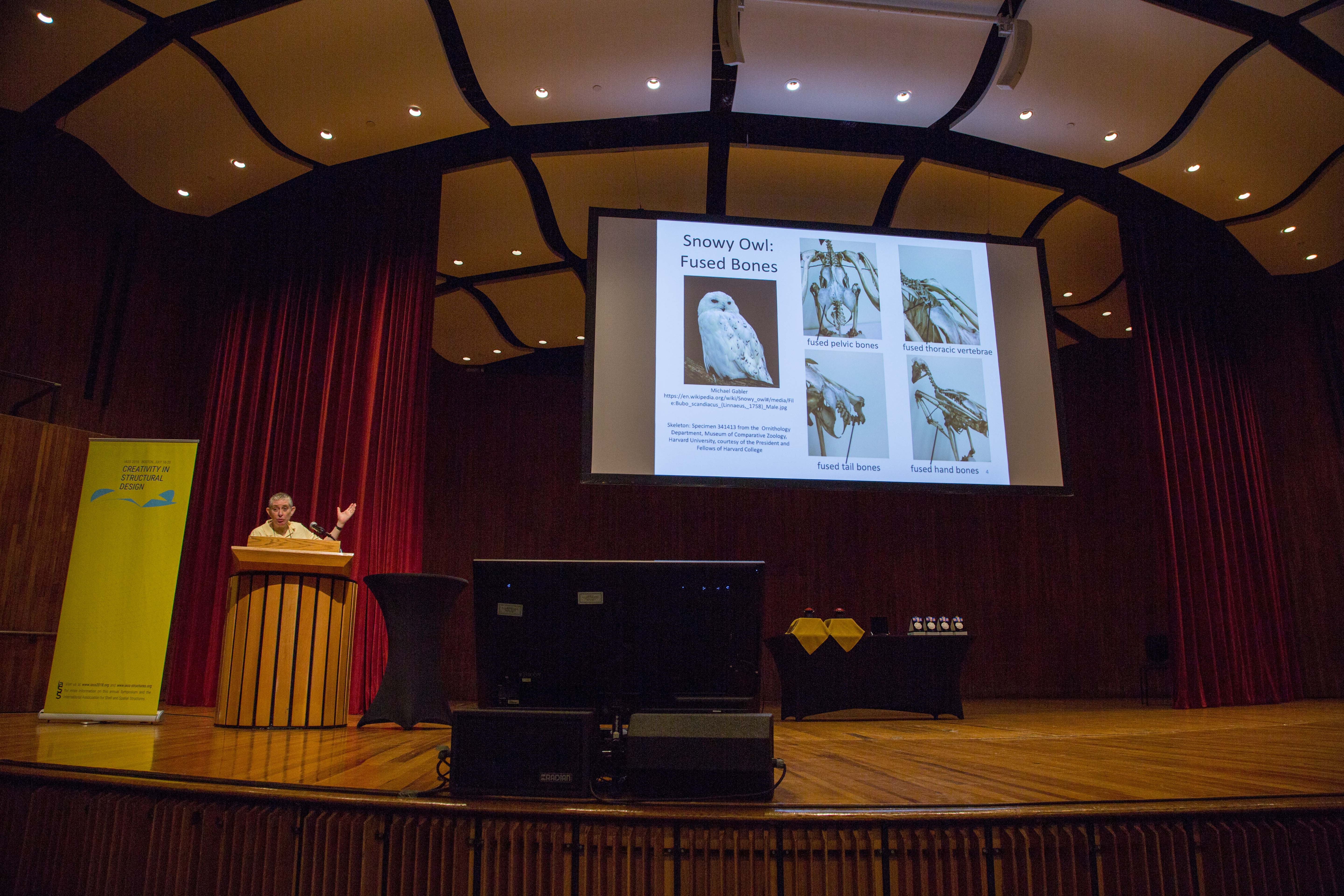
Professor Lorna Gibson gives a keynote at IASS 2018, hosted at MIT.Demi Fang: The theme of the conference is “Creativity in Structural Design.” How do you interpret this theme? What does it bring to mind?
Lorna Gibson: I’ve looked at a lot of natural materials. I look at how they behave mechanically and see what their natural mechanisms of deformation and failure are, and then to try to see what we can learn from those materials for engineering design. This bio-inspired design approach is one we share with a lot of other people.

Cellular structures in plants: cross-section of an iris leaf. (Microscopy: Don Galler)DF: What methods do you use to fuel creativity? In what ways do you blend the technical and creative aspects of your work?
LG: I think creativity often arises from doing interdisciplinary things. You become an expert in one field, but then you look at other fields and see they have different ways of doing things: they look at problems differently, or they have different kinds of problems. The way you approach things in a different field makes you rethink in your own field. I think having interdisciplinary research and having people collaborate from different fields is one way that people can be creative.

Engineering honeycombs and foams: elastomeric polymers, undeformed (a, b) and deformed in-plane (c-f). L. J. Gibson and M. F. Ashby, Cellular Solids: Structure and Properties, 2 edition. Cambridge: Cambridge University Press, 1999.DF: Describe the collaborations in your work.
LG: In our bamboo project, we collaborated with architects in Cambridge and with a wood scientist at the University of British Columbia. The architects were interested in large-scale members, thinking about how the members would be used in actual design and building codes. The wood scientist was interested in the processing of the bamboo; he had worked on the processing of wood composites like oriented strand board (OSB), the particle board, so he took what he knew about processing wood and applied it to the bamboo. Our contribution from MIT was looking at the material science of the bamboo—modeling the microstructure and the mechanical properties of the material. The nice thing about the project was that it went from looking at the microscopic structure of the bamboo, to looking at how you could process the bamboo, to looking at how you would actually use it in a building. It’s too difficult for a single person to span all those different areas of expertise, but by collaborating, we were able to do that.
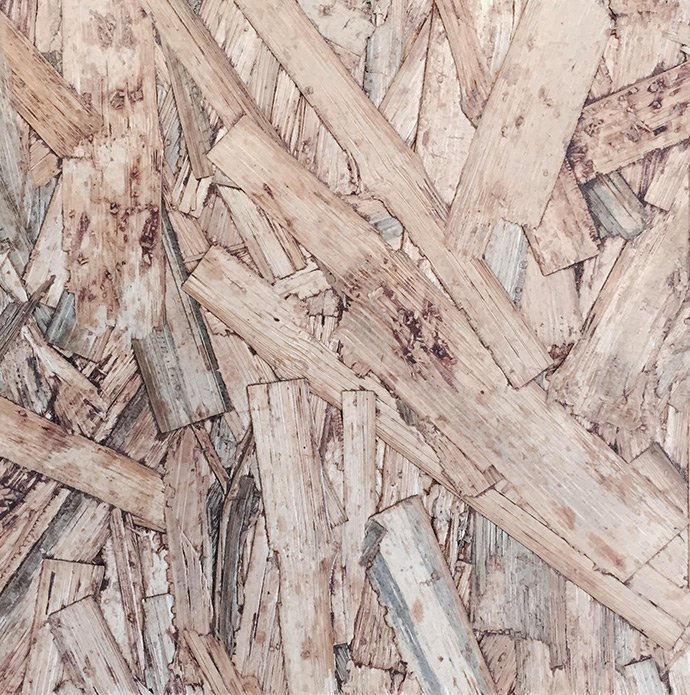
Bamboo oriented strand board, fabricated by Dr. Greg Smith’s group at University of British Columbia.DF: What are are some pressing, interesting technical challenges that you anticipate in the future in your field?
LG: My field is cellular materials—porous materials like honeycombs and foams. There’s a lot of interest right now in lattice materials, these three-dimensional truss materials, and in how to optimize these materials, optimize their structure, optimize the material you make them from, make them at smaller length scales... I think there’s still a lot of work that remains to be done in that area. There’s also a lot of interest in natural cellular materials—we worked on bamboo, but there’s also trabecular bone, wood, and plant structures. Some of these have very complex structures and I think people will continue working on them.

Trabecular bone is porous bone found at the ends of long bones and within the vertebrae, skull, and pelvis. Micrograph of cross-sections of lumbar vertebrae of a 55-year-old woman (left) and an 86-year-old woman (right). S. Vajjhala, A. M. Kraynik, and L. J. Gibson, “A cellular solid model for modulus reduction due to resorption of trabeculae in bone,” J Biomech Eng, vol. 122, no. 5, pp. 511–515, Oct. 2000.DF: Describe the impact of your work outside of academia.
LG: I’ve written several books on cellular solids and they’ve been quite widely used in industry. Outside of my research, I also worked a lot on equity issues for women here at MIT. Each of MIT’s five schools had a committee to help report on the status of women faculty at MIT; I chaired the committee in the school of Engineering. [These efforts resulted in the 2002 Reports of the Committees on the Status of Women Faculty.] I think the collective impact of all of those efforts really had a lot of effect at a lot of places, both in academia and in government and in industry. At the time, it got a tremendous amount of press. The president of MIT, Chuck Vest, had admitted that MIT had discriminated against women faculty, and he and his administration were willing to do things to change MIT. I think that got a lot of attention in lots of places.
Is it perfect now? No, but when I look at what things were like when I was a student – not here, but in Toronto – back then, and what it was like when I came to MIT, and what it’s like now at MIT, it’s totally different.
DF: What advice would you give to your past self or to today’s students?
LG: When I was a graduate student [at the University of Cambridge], my adviser Mike Ashby had been interested in developing this project on cellular solids. He had had a couple of undergraduate students do a senior thesis project on it, but he couldn’t get any graduate students to work on it; nobody wanted to do it with him because it wasn’t a hot, trendy topic at the time (e.g. fracture mechanics, composites). I wasn’t thinking necessarily about becoming a professor and wasn’t worried too much about what I was going to do with it; it just seemed like a really interesting project. My background was in civil engineering, and the topic was like structures but on a tiny length scale.
I worked on it because I thought it was a really interesting project. My thinking was that I’ll learn a lot, and whatever I learn I can apply to the next thing. I never really anticipated I would spend decades after that working on cellular solids! So you don’t always have to do the hot, trendy topic; it’s okay – almost better – to do what’s not hot and trendy because then you can make a big impact developing something new.
DF: What is something you are currently working on that excites you?
LG: I’ve been particularly involved with online teaching on MITx [MIT’s free online courses on edX]. We made a series of videos on how woodpeckers avoid brain injury as part of MITx, and I’d like to make some more videos like that.

Still from Gibson’s “Built to Peck: How Woodpeckers Avoid Brain Injury” MITx series, 2016.DF: How did you get into studying birds?
LG: I’m an amateur bird-watcher, but I like natural history and I like nature. When I was a student, somebody visited our lab and said that woodpeckers had a special cellular material that protected their brains from injury, and that’s how I got interested in the woodpecking thing. There is no such material in their heads. But then I got curious about what was going on instead.
This interview originally appeared in the proceedings for IASS 2018 at which the interviewee was a keynote speaker. These interviews make their first appearance online in this co-published series between this blog and the Form Finding Lab blog with the aim of inspiring a broader audience with the thoughts and insights of these outstanding individuals. Stay tuned on both blogs for more!
More in the series: Neri Oxman | Janet Echelman | Tomohiro Tachi
-
 The Arc Lamp workshop at AAG 2018: active bending and digital fabrication
The Arc Lamp workshop at AAG 2018: active bending and digital fabricationDigital Structures' Caitlin Mueller, Paul Mayencourt and Pierre Cuvilliers were in Gothenburg, Sweden this September 2018, teaching a workshop on active bending at the Advances in Architectural Geometry conference hosted at Chalmers University. In this workshop, we explored the design of bending-active structures with variable cross-sections to fit a target design shape. Over the two days, the participants used computational form-finding tools for bending-active structures, and each designed and built an arc lamp. The participants learned state-of-the-art methods for simulating bending-active behavior and for the control and optimization of their equilibrium shapes. These methods could be applied to the design of large-scale bending-active structures such as elastic gridshells.
After a short introductory lecture on active bending structures, the workshop immediately got very practical, with the participants testing the plywood we would use to build the lamps, determining stiffness and resistance. With these values on hand, it was time to start trying out the design workflow on small-scale prototypes. Small teams formed, first design ideas emerged, and we started comparing the designs against their simulated shapes and against each other. The prototypes were laser-cut sheets of plywood, with rudimentary attachments; this made iterating on designs a lot easier.



This prototyping stage gave everyone a better sense of the design space we were exploring, and let us start exploring the limits of the software tools. For the next step, we designed lamps at a much larger scale: 2-to-4-meter strips of plywood, from 4-mm- and 6-mm-thick sheets. After finalizing the designs, it was time to start up the CNC router.


As soon as the cuts were ready, it was assembly time. We fabricated bases for the lamps in the beautiful wood workshop of Chalmers University, then moved to the conference space where the lamps would stay on display for 3 days.

Most lamps found their spot next to another bending-active structure, a wooden pavillion designed by Alexander Sehlström.


The rest was spread around the conference space, and all were very intriguing.


Some construction details:


All the lamps we built:

Overall, a great workshop. We all learned a lot in these two days!







